How to Choose the Perfect Extender Screen

Picking the best extender screen can change your experience. Whether you’re doing many tasks or watching shows, the right screen matters. The VEOUT portable monitor is stylish and high-quality. It suits your needs, helping you stay busy and have fun easily.
Key Takeaways
Check your laptop's system and ports to match the extender screen.
Pick a screen size and resolution that fits your needs; big screens help with editing, small ones work for simple tasks.
Think about portability and style; light, foldable screens are easy to carry and set up fast.
Compatibility
Operating System and Driver Needs
Make sure the extender screen works with your laptop’s system. Some screens need special drivers, like DisplayLink, to work well. These drivers are key for USB docks and adapters but might slow things down or lower screen quality.
Here’s a simple driver guide:
Driver Type | What It Does | Possible Issues |
|---|---|---|
DisplayLink | Needed for USB docks and adapters to work right. | May cause slower performance or lower display quality. |
Also, check if your laptop is strong enough for the extender screen. Using many screens can make your laptop work harder. Match your laptop’s power with what you need.
Laptop Ports and Connection Choices
Your laptop’s ports are important for compatibility. Many extender screens, like the Veout 16inch Portable Monitor, use USB-C and HDMI. If your laptop has a good Type-C port, one cable can handle power and display. If not, you’ll need USB-A and HDMI cables.
Here’s a quick port guide:
Port Type | What It’s For |
|---|---|
Type-C Port (One Cable) | Works if your laptop has a full-featured Type-C port. |
USB-A & HDMI Ports | Use these if Type-C isn’t available, needing two separate cables. |
Check your laptop’s ports to avoid setup problems.
Graphics Card and Performance Match
Your laptop’s graphics card decides how well it runs an extender screen. For gaming or design, you’ll need a strong GPU. For simple tasks like browsing, most laptops are fine. Think about how you’ll use the screen and match it to your laptop’s power.
Tip: Want to use more than one screen? Check your laptop’s specs to make sure it can handle the extra work without slowing down.
Screen Size and Resolution

Picking the Best Screen Size for You
The screen size you need depends on your tasks. For editing photos or videos, a bigger screen helps. For simple browsing or light work, a smaller screen works fine. Think about where you’ll use it. A 16-inch screen, like the Veout 16inch Portable Monitor, is a good choice. It’s big enough to see clearly but easy to carry.
Knowing Resolution and Picture Quality
Resolution affects how clear your screen looks. Higher resolution means sharper images with more detail. For example, the Veout monitor has 1920 x 1200P resolution. This gives clear pictures for work or fun. Also, check the display type. An IPS panel shows bright colors and wide angles. This means the screen looks great from any seat.
Matching Screen Features to Your Needs
Choose screen features based on your activities. For work, pick a screen with clear visuals and space to multitask. Gamers should look for smooth play features like Freesync. If you travel, pick a slim and light screen. The Veout monitor fits all these needs, making it a great choice.
Portability and Design

Light and Thin for Easy Travel
Carrying heavy gadgets can be annoying when traveling. That’s why a light and thin extender screen is helpful. Picture sliding a slim 16-inch screen into your bag easily. Some screens weigh just 2.76 pounds and are super thin. This makes them great for trips. A slim screen saves space and fits well with your laptop. Whether at a café or on a plane, a portable screen keeps you productive.
Foldable and Small Designs
Foldable and small designs save space when traveling. Many screens now have adjustable stands or foldable frames. These features let you set up quickly and store neatly. Some screens even rotate 210°, letting you adjust the angle. This makes working comfortable anywhere, like at home or on a train. Compact designs also fit easily in your bag without taking up much room.
Simple Setup and Storage
No one likes spending too much time setting up. Most extender screens connect fast with one USB-C or HDMI cable. Some screens combine video, power, and data in one cable. This reduces mess and keeps things simple. Many screens include all needed cables, so you’re ready to go. Their light and small size make packing up easy. You can focus on work or fun without extra trouble.
Connectivity Options
USB-C or HDMI: Which One Should You Pick?
To connect your extender screen, USB-C and HDMI are common choices. But which is better? USB-C is very popular now. It can send power, video, and data using one cable. This means fewer wires and a neat setup. Many new laptops and screens, like the Veout 16inch Portable Monitor, work well with USB-C.
HDMI is still widely used and dependable. It’s great for clear video and sound. But it often needs a separate power cable, which adds clutter. Here’s a quick comparison:
Connectivity Options | Growth in Use | Key Features |
|---|---|---|
USB-C | Makers keep improving it | |
HDMI | Used in many areas | High-quality extenders available |
If your laptop has USB-C, choose it. If not, HDMI is a good backup.
Using Multiple Screens for More Productivity
Adding more screens can help you do more tasks easily. Many extender screens now use simple plug-and-play with USB-C. They work with both Windows and MacOS, making them flexible. For example, the Veout monitor can rotate 210°. This lets you share your screen or adjust it for comfort while working or gaming.
Here’s what a good extender screen offers:
Feature | Benefit |
|---|---|
Screen Resolution | |
Display Type | IPS |
System Compatibility | Works with Windows and MacOS |
Connection Type | USB-C |
These features make setting up easy and efficient.
Matching Your Laptop to the Extender Screen
Not all laptops are the same, so pick a screen that fits your laptop’s power. Gaming laptops with GPUs like NVIDIA GeForce RTX 3060 can handle 1080p or 1440p screens well. Work laptops with NVIDIA Quadro GPUs can run many high-resolution screens. But older laptops with basic graphics may struggle with 4K or heavy tasks.
Tip: Check your laptop’s specs before buying a screen. This helps you avoid problems and get the best performance.
Durability and Build Quality
Strong Materials and Good Design
Pick an extender screen that feels tough and well-made. Good materials make it last longer. Many screens, like the Veout 16inch Portable Monitor, are thin and stylish. They look nice and handle daily use well. Some even have clear back panels for a fancy touch. People often say these screens feel strong when held. Also, since they don’t clip onto laptops, there’s less chance of breaking them during setup.
Scratch Protection and Steady Use
A strong screen should resist scratches from daily use. Look for scratch-proof coatings to keep it looking new. Stability is also important. A good extender screen stays firm on your desk or table. Adjustable stands, like on the Veout monitor, help keep it steady. You can also tilt it for the best view. Whether at home or traveling, these screens stay in place and work well.
Warranty and Helpful Support
A warranty shows the company trusts its product. Most screens come with at least a one-year warranty. This gives you confidence in your purchase. Good customer support is also key. If there’s a problem, you’ll want fast and friendly help. For example, Veout offers easy returns if needed. Knowing you’re covered makes buying the screen a smart choice.
Budget and Value
Setting a Realistic Budget
When buying an extender screen, plan your budget wisely. Think about how you’ll use it. Do you need a simple work screen or a gaming display? Your choice will decide how much to spend. For basic use, good screens cost under $250. For better features like sharper images or gaming tools, expect to pay more. Knowing what you need helps you spend smartly and get the right screen.
Comparing Features Across Price Points
Extender screens have different features, and prices show this. Here’s a comparison of some popular models:
Model | Size | Resolution | Connectivity | Power | Price |
|---|---|---|---|---|---|
VEOUT V1 | 16 inches | 1200p | USB-C, USB-A | Via laptop | $119.99 |
ASUS ZenScreen MB16AC | 15.6 inches | 1080p | USB-C | Via laptop | $249 |
Lenovo ThinkVision M14 | 14 inches | 1080p | USB-C | Via laptop | $239 |
Match the features to your needs for the best deal.
Balancing Cost with Quality and Performance
Balancing price and performance is important. Cheaper screens save money but may lack sharp visuals or good ports. High-end screens, like the Veout 16inch Portable Monitor, offer great visuals and easy use. Spending more can improve your work and fun. Always compare features and prices to get the best value.
Choosing the right extender screen can make a big difference in your daily life. Think about what you need most—whether it’s portability, durability, or great visuals. A screen like the Veout 16inch Portable Monitor checks all the boxes. It’s slim, stylish, and perfect for work, gaming, or travel. Why settle for less?
FAQ
How should I connect an extender screen to my laptop?
Use a USB-C cable if your laptop allows it. This cable sends power, video, and data all at once. It keeps your setup clean and easy to manage.
Can I play games using an extender screen?
Yes, you can! Many screens, like the Veout 16inch Portable Monitor, are great for gaming. They have features like Freesync for smooth visuals, making games more fun.
How can I check if my laptop works with an extender screen?
Look at your laptop’s graphics card and ports. Newer laptops usually work well, but older ones might struggle with high-resolution or extra screens.
Tip: Check your laptop’s details before buying an extender screen. This helps avoid problems with compatibility.
